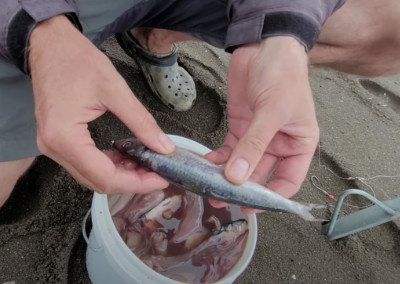Did you ever wonder how you can make your baits last longer, store them without the need of a freezer and at the same time make them more attractive to fish?
Well, you have come to the right place. In this article, we are going to show you how you can salt-brine your baits to supercharge them for your next fishing trip.
Brining fish bait is actually quite simple and somewhat similar to dry-salting baits.
I have found over the years that brining baits is, in general, easier and more effective.

The reason for this is that the baits stay a little softer when submerged in brine and soak in a lot of extra flavour and scent which fish love.
There is no need for refrigeration and you can even add leftover bait that has been defrosted but wasn’t used during a fishing trip. You wouldn’t be able to re-freeze such bait, but it’s perfectly fine to brine it.
The purpose of heavy salt brine is that the salt removes water from the bait through a process called osmosis. Water is what makes bait spoil quickly. The water gets drawn out from the cells and mixes with the brine. The salt then prevents any spoilage. Bacteria cannot live in salt and this knowledge has been used for millennia, even to this day, to preserve food for human consumption. So it can’t be wrong to use the same process to preserve bait for fish, right?
Another big advantage of salting and brining baits is that those baits also become a little tougher and in turn stay on the hook more easily. If you dry-salt baits they can become too tough and shrivel up to a point where fish won’t want to eat them. But with a salt brine the baits won’t get too tough because they are immersed in liquid for the whole time.
So let’s have a look at how we do it. By the way, we also made a youtube video on brining baits. We’ll leave a link at the bottom of this article, so make sure to check it out to learn more about this process.
As I said, brining baits is easy. All you need is a bucket half full with brine and then add your fresh or frozen bait. We use a bucket with a sealable lid. You don’t want to have the brine spill all over your vehicle. These kinds of buckets are available from most hardware stores.
We found a 2-3 gallon bucket ( 5 - 10 litres) is about the right size.

We fill the bucket a quarter or half full with tap water. Depending on how much bait we have.
Next, we have to figure out how much salt we want to use.
The salt concentration determines how long you can keep your bait in the brine and how much its consistency will change.
A light brine of around 30 per cent salt works well for shorter periods of storage. Let’s say a few weeks at the most. Keep in mind that when you add bait the salt concentration gets lower because the bait contains water.
The salt content in the dead sea for example is 30 per cent and nothing lives there, hence it’s called the dead sea. So this is a good starting point for a light brine. To have a salt concentration of 30 per cent after adding bait we start with at least a 40 per cent salt to water ratio before adding the bait. So for each litre of water, we add 400 grams of salt.
It’s easier to work with scales and weigh the salt and water to get the ratios right.
Keep in mind that 40 per cent is the bare minimum for salt brine. We often use much higher ratios if we want to keep our bait for longer.
Also, keep in mind that if you add more bait later on the salt content will be reduced. So by starting with a higher salt concentration you don’t have to worry about adding more salt later on.
For that reason, we often go as high as an 80-100 per cent salt to water ratio. The bait will become a little tougher with such a high salt content but fish don’t seem to mind and we had good success with this high salt content.
So how much salt you use is really up to your preferences and how long you want to keep the bait before fishing. If you intend to fish within a week or two then go with a lighter brine of 40 per cent and if you intend to keep the bait for longer periods go with a strong brine of 80 - 100 per cent.
So after we figure out the ratio we want to use we add the salt to the water in the bucket and mix until it is completely dissolved.
As for the salt, you want to avoid using iodized salt as this can make the baits somewhat bitter and less effective. Natural un-iodized table salt or sea salt works best.
Once the brine is mixed up you can just add your frozen baits or fresh baits directly, make sure they are completely submerged in the brine, close the lid and you’re done.
Over the next few days, you will notice that the consistency of your baits starts changing.
They become a lot more oily and a little tougher. After longer periods in the brine, they start to look a little like canned fish, that is preserved in oil.
To prevent the bait from changing color and becoming dull you can add a package of baking soda to your brine together with the salt. This will provide extra protection from spoilage and will also help to keep the baits looking more colourful and shiny. This could help attracting more fish.
If we do a quick brine we usually skip the baking soda. But if we intend to brine for longer periods we add the additional baking soda and found that this works really good.
So there you have it. Brining bait is really simple. You can use any baits and even mix them.
Oily baits like pilchards, mackerels, etc work really good. Soft baits such as mussels and shrimps can also be easily preserved in this way.
There is no need for refrigeration. Just keep the bucket shut and store it in a cool place out of direct sunlight. If it gets too hot you might accidentally cook your baits :)
You can leave the bucket on your boat, in a garage or in your camper. And whenever you need bait you’ll have it ready to be fished without clogging up your freezer and having to defrost it first.
Every serious bait fisherman should know about brining bait. Once you start using this technique you won't look back.
We hope this article was somewhat helpful to you and please make sure to watch our youtube video on brining baits. In this video, we are going through the above steps and show you how we fish with the brined baits.
Video on brining bait for fishing


No comments yet. Be the first to comment!